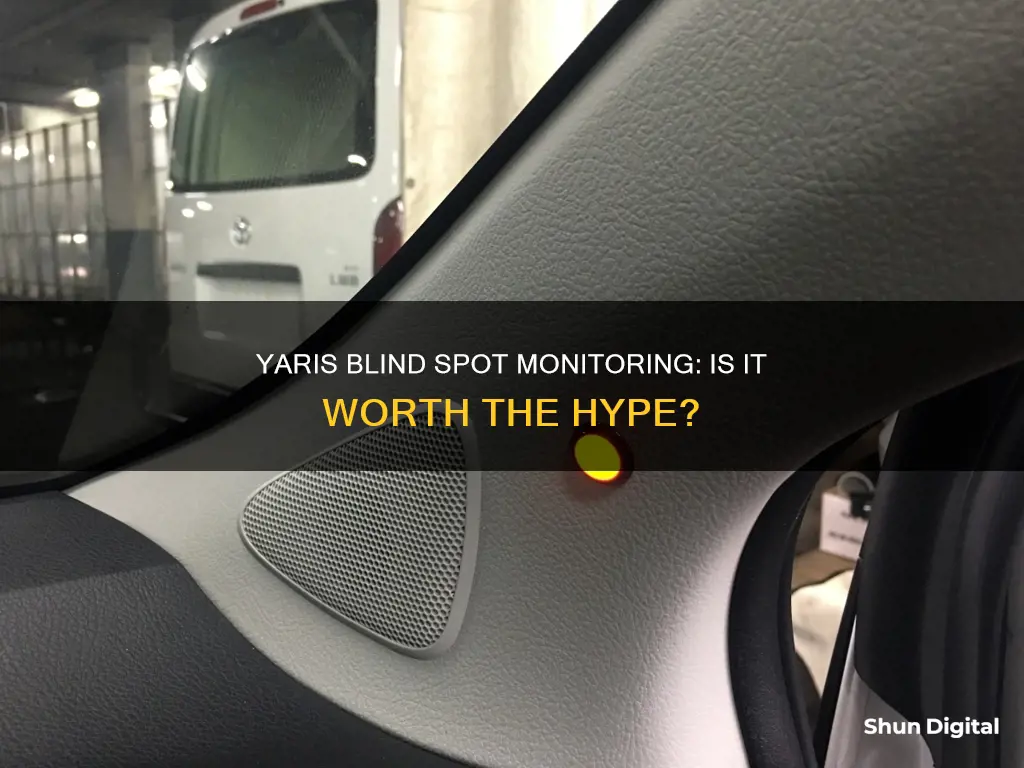
The Toyota Yaris is a popular car model that has been in production since 2016. One of the key features that contribute to its popularity is its focus on safety. The Yaris is equipped with advanced driver assistance systems, including Toyota Safety Sense, which offers features such as a Pre-Collision System, Intersection Turn Assistance, and Lane Departure Alert with Steering Control. In addition, the Yaris also offers a Blind Spot Monitoring (BSM) system, which is designed to assist drivers in checking their blind spots while driving and during lane changes. This system uses sensors and cameras to detect vehicles approaching from the rear and alerts the driver through visual and auditory warnings. The BSM system in the Yaris has received positive reviews for enhancing safety and improving the overall driving experience.
| Characteristics | Values |
|---|---|
| Blind Spot Monitoring | Detects vehicles approaching from the rear while travelling forward at a speed of 6.3 mph or faster |
| Rear Cross Traffic Alert | Detects vehicles that may be crossing your path when reversing out of a parking spot or driveway |
| Activation | Press the BSM button on the dashboard to the left of the steering wheel |
| Alerts | Lights on the side mirrors illuminate and flash when a vehicle is in the blind spot |
What You'll Learn

The Blind Spot Monitoring (BSM) system in the 2016 Yaris
The detection area covered by the BSM system includes the driving lanes on both sides of the Yaris and extends from the rear part of the front doors to about 164 ft (50 m) behind the vehicle. This feature is designed to improve safety when changing lanes, but it is important to note that it should not be relied upon exclusively. Drivers should always physically check their blind spots and use their turn signals when changing lanes.
To activate the BSM system in the 2016 Yaris, press the BSM button on the dashboard to the left of the steering wheel. You will hear a chime, and the lights on the side mirrors will illuminate for a few seconds. When the system detects a vehicle in your blind spot, the light on the corresponding side mirror will light up. If you switch on your turn signal at this point, the light will flash to alert you to the presence of a vehicle in your blind spot.
The 2016 Yaris also features Rear Cross Traffic Alert, which is similar to the Blind Spot Monitor but specifically detects vehicles that may be crossing your path when reversing out of a parking spot or driveway. This feature works when you are backing up at a speed of 5 mph or less and can detect vehicles travelling between 5 and 18 mph from the left or right. If a vehicle is detected, a warning tone will sound, and the light in the respective side mirror will illuminate.
Monitoring Bandwidth Usage: PRTG's Per-IP Address Insights
You may want to see also

How to turn on the BSM feature
The Toyota Yaris is equipped with some of the most advanced driver assistance systems, including Blind Spot Monitoring (BSM). This innovative safety feature can help detect and alert you to vehicles in your blind spot, improving safety on the road.
To turn on the BSM feature on your Yaris, locate the BSM button on your dashboard, which should be to the left of the steering wheel. Press this button, and you will hear a chime sound, and the lights on your side mirrors will illuminate for a few seconds. This indicates that the BSM feature is now active.
Now that BSM is turned on, here's how it works while driving: If a vehicle enters your blind spot, the light on the respective side mirror will light up. If you then switch on your turn signal, indicating you intend to change lanes, the light will start flashing to draw your attention and let you know there is a vehicle in your blind spot. This is especially useful as it provides an additional visual alert on top of the standard audio warning beeps.
Remember, while the BSM feature in the Yaris can improve safety, it is important not to rely on it exclusively. As with any technology, it has limitations in terms of function, detection, and monitoring range. Always remain vigilant, look over your shoulder, and use your turn signal when changing lanes.
Disassembling LCD Monitors: Safe or Risky?
You may want to see also

BSM limitations and when not to use it
Blind Spot Monitoring (BSM) is a useful feature in vehicles to assist drivers in changing lanes safely. While it is a valuable tool, it is important to understand its limitations and when not to rely solely on it. Here are some scenarios where BSM may have limitations or not be suitable to use:
- Obstacle Detection: BSM typically uses sensors or cameras to detect vehicles in adjacent lanes. However, it may not always detect smaller objects like motorcycles, bicycles, or pedestrians. It is crucial to visually check your blind spots and use mirrors for a comprehensive view.
- Speed and Distance: The system's effectiveness can vary with speed and distance. At higher speeds, the system may not detect vehicles in adjacent lanes if they are too close or in your blind spot for an extended period. Similarly, at lower speeds, the system may not detect slower-moving objects or stationary vehicles.
- System Limitations: BSM systems have technological limitations. They may not always detect fast-approaching vehicles or those with inconsistent speeds, such as vehicles preparing to merge. Additionally, adverse weather conditions like heavy rain or snow can affect sensor performance.
- System Malfunctions: Like any technology, BSM systems can experience malfunctions or failures. False alerts or a lack of alerts may occur due to sensor issues, incorrect calibration, or damage to the system. It is important to regularly maintain and calibrate the system to ensure optimal performance.
- Driver Dependence: BSM systems are designed to assist drivers, not replace their responsibility. Drivers should not solely rely on BSM and must still remain vigilant and actively monitor their surroundings. It is essential to use BSM as a supplementary tool rather than a replacement for safe driving practices.
- Blind Spot Coverage: BSM systems have specific coverage areas, typically focusing on the rear corners of the vehicle. Objects outside these monitored areas, such as vehicles in front or diagonal to your car, may not be detected. It is important to understand the limitations of your vehicle's specific BSM system.
In summary, while Blind Spot Monitoring systems offer valuable assistance, they have limitations. Drivers should understand the capabilities and potential shortcomings of the technology. BSM should be used as a supplementary tool to enhance safety, not as a replacement for safe driving practices and staying alert.
Blind Spot Monitoring: A Mini Safety Feature?
You may want to see also

Rear Cross Traffic Alert
The Toyota Yaris is a highly safe car, with a number of features that make it the safest model in its segment. One of these features is the Rear Cross-Traffic Alert (RCTA) system, which is part of the Toyota Safety Sense package. This package includes more electronic safety features than any other B-segment competitor.
The RCTA system detects potential impact hazards during reversing manoeuvres and alerts the driver to vehicles approaching from behind on the road. This helps to prevent accidents and improve safety, especially when backing out of parking spaces or driveways. The system uses sensors and cameras to monitor the area behind the car and can provide both visual and audible alerts to the driver if an object or vehicle is detected.
The RCTA system in the Yaris can also be paired with automatic braking, further enhancing the safety of the vehicle. This means that if the driver does not react to the alerts, the car will automatically apply the brakes to avoid a collision. This feature is known as Rear Cross Traffic Braking (RCTB) and is available on certain Yaris models, such as the 2020 New Yaris Launch Edition.
The RCTA system is a valuable addition to the Yaris, providing drivers with greater peace of mind and helping to prevent accidents. It is a standard feature on many Yaris models and can be included as part of the City Pack, which also includes front and rear parking sensors, auto-folding door mirrors, and a Blind Spot Monitor. This comprehensive suite of safety features demonstrates Toyota's commitment to making advanced safety provisions widely available.
Understanding the ASUS ACPI Monitor Application
You may want to see also

Other safety features of the Yaris
The Yaris has a range of safety features that make it one of the safest cars in its segment. Firstly, the Yaris has a highly rigid body and a state-of-the-art Toyota Safety Sense system, which includes advanced driver assistance features. The Yaris is built on the GA-B platform, which increases torsional rigidity to a class-best standard, enhancing impact absorption and protecting the passenger cabin in collisions.
The Yaris is also the first Toyota equipped with centre airbags, which deploy during side impacts to prevent the driver and front passenger from colliding with each other. Additionally, the Yaris has a Pre-Collision System with an integrated camera and radar that can detect and warn the driver about pedestrians and cyclists in the car's path. The system also provides visual and audible warnings and activates brake assistance to prevent collisions.
Another safety feature is the Intersection Turn Assistance system, which detects potential hazards at junctions and can apply automatic emergency braking to avoid collisions. The Yaris also has Adaptive Cruise Control, which maintains a safe distance from the preceding vehicle and brings the car to a halt if necessary. The Lane Departure Alert with Steering Control and Lane Trace Assist feature warns the driver if they deviate from their lane and can automatically centre the vehicle or follow the path of the vehicle ahead when road markings are unclear.
Furthermore, the Yaris has Emergency Steering Assist, which provides additional steering torque when necessary to avoid obstacles or pedestrians, while also maintaining vehicle stability. The Rear Cross-Traffic Alert and
The Yaris also has Intelligent Clearance Sonar with automatic braking, where ultrasonic sensors at the rear detect objects and automatically apply the brakes if the driver does not react to audible warnings. Other notable safety specifications include automatic headlights and wipers, a reversing camera, an electronic parking brake, and smartphone integration.
Overall, the Yaris is designed with an impressive array of safety features, ensuring peace of mind for drivers and passengers alike.
Setting Up Monitors: A Desktop Guide
You may want to see also
Frequently asked questions
Yes, the Yaris is equipped with blind spot monitoring. This feature includes a Blind Spot Monitor and Rear Cross Traffic Alert to help detect and alert you to vehicles in your blind spot.
To turn on the blind spot monitoring feature, press the BSM button on the dashboard to the left of the steering wheel. You will hear a sound chime and see the lights illuminate on the side mirrors for a few seconds. While driving, if a vehicle is in your blind spot, the light on that side mirror will light up. If you switch on your turn signal at this time, the light will flash to draw your attention.
The detection area covers the driving lanes on both sides of the vehicle and from the rear part of the front doors to about 164 ft (50 m) behind the Yaris.
While both features help draw attention to vehicles in your blind spot, Rear Cross Traffic Alert specifically detects vehicles that may be crossing your path when reversing out of a parking spot or driveway. It works when you're backing up at a speed of 5 mph or less and can detect vehicles going between 5 and 18 mph from the left or right.
No, while these features can improve safety, drivers should not rely exclusively on them. As with any technology, the blind spot monitoring feature has limitations in terms of function, detection, and monitoring range. Drivers must always look over their shoulder and use their turn signal.







